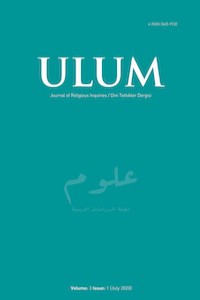Abdurrahim Karahisârî’nin Tasavvufî Görüşleri ve Münyetü’l-Ebrâr ve Gunyetü’l-Ahyâr İsimli Eseri (Metin ve İnceleme)
Öz
15. yüzyıl ve özellikle de bu yüzyılın ikinci yarısına denk gelen, İstanbul’un fethinden sonraki süreç Osmanlı Devleti’nin hem siyâsî ve bürokratik açıdan hem de ilmî ve kültürel açıdan teşkilâtlanmasında en kritik adımların atıldığı dönemdir. Bu süreçte öncelikle II. Murad döneminde ivme kazanan tercüme ve te’lîf hareketleriyle Türkçenin bir ilim ve kültür dili olmasına zemin hazırlanmıştır. Bu yüzyılda Anadolu topraklarında teşekkül eden ilk yerel tarîkat olan Bayramiyye de mensuplarının ürettiği eserlerle bu entelektüel hareketin önemli ocaklarından biri olmuştur. Hacı Bayram-ı Velî’nin (ö. 833/1429–30) mürîdlerinin yaptığı Lema‘ât ve Gülşen-i Râz gibi tasavvuf yazınının temel bazı eserlerinin çevirisiyle başlayan bu kültürel üretim süreci Yazıcıoğlu Mehmed (ö. 855/1451) ve Ahmed Bîcân (ö. 870/1466’dan sonra) kardeşlerin te’lîf ve tercümeleriyle devam etmiştir. Bizzât Akşemseddîn’in de kendi risâleleriyle katıldığı sürece, onun önde gelen halîfeleri olan Ibrahim Tennûrî (ö. 887/1482) ve Abdurrahim Karahisârî (ö. 888-900/1483-94 arası) de kendi eserleriyle destek vermişlerdir.
Bu çalışma [Abdurrahim Karahisârî’nin Tasavvufî Görüşleri ve Münyetü’l-Ebrâr ve Gunyetü’l-Ahyâr İsimli Eseri (Metin ve İnceleme), Doktora Tezi, Marmara Üniversitesi, Sosyal Bilimler Enstitüsü, Temel İslam Bilimleri Anabilim Dalı, Tasavvuf Bilim Dalı, İstanbul, Türkiye, 2019], böyle bir zaman bağlamında yaşayan ve eser veren Abdurrahim Karahisârî’nin tasavvufî görüşlerini konu edinmektedir. Çalışmanın temel amacı Karahisârî’nin, eserlerinden, özellikle de müstakil olarak tasavvufî bir mevzûya odaklanan tek eseri olan Münyetü’l-ebrâr ve gunyetü’l-ahyâr’dan hareketle tasavvufî görüşlerini gün yüzüne çıkarmaktır. Karahisârî’nin günümüze ulaşan dört eseri olsa da hayâtı hakkındaki biyografik ve çevresi hakkında bilgi veren prosopografik kayıtlar oldukça sınırlıdır. Dolayısıyla, çalışmanın gâyesine ulaşabilmesi adına ilk yapılması gereken Karahisârî’nin biyografisini ve muhitini ortaya çıkarmaktır.
Anahtar Kelimeler
Tasavvuf Osmanlı Tasavvufu Bayramiyye Akşemseddîn Abdurrahim Karahisârî Konevî
Kaynakça
- Orhan, Abdullah Taha. Abdurrahim Karahisârî’nin Tasavvufî Görüşleri ve Münyetü’l-Ebrâr ve Gunyetü’l-Ahyâr İsimli Eseri (Metin ve İnceleme). Doktora Tezi, Marmara Üniversitesi, Sosyal Bilimler Enstitüsü, Temel İslam Bilimleri Anabilim Dalı, Tasavvuf Bilim Dalı, İstanbul, Türkiye, 2019.
Abd al-Rahim Karahisārī’s Mystical Thoughts and His Munyat al-Abrār and Ghunyat al-Akhyār (Text and Analysis)
Öz
The period after the conquest of Istanbul, especially the second half of this century, was the period when the most critical steps were taken in the organization of the Ottoman Empire both politically and bureaucratically as well as scientifically and culturally. Before this era, with translation movements that gained momentum during the Murad II’s reign, the ground was prepared for Turkish to become a medium of science and culture. In this century, Bayramiyya, the first local sūfī order in Anatolia, was one of the important centers of this intellectual movement with the works produced by its members. This cultural production commenced with the translation of some of the sūfī works such as Lama‘āt (“Divine Flashes”) and Gulshan-i rāz (“The Garden of Mystery”) undertaken by Hacı Bayram-ı Velī’s (Ḥājjī Bayram Walī, d. 833/1429–30) disciples, continued with the writings and translations of the brothers, Yazıcıoğlu Mahmad and Ahmad Bīcān. While Aq Shams al-Dīn (Akşemseddin in modern Turkish, d. 863/1459) participated in this process with his treatises, also Aq Shams al-Dīn’s successors Ibrahim Tennūrī and Abdurrahim Karahisārī supported them with their works.
This study [Abd al-Rahim Karahisārī’s Mystical Thoughts and His Munyat al-Abrār and Ghunyat al-Akhyār (Text and Analysis), PhD. Dissertation, Marmara University, Institute of Social Sciences, Department of Sūfism, İstanbul, Turkey, 2019] mainly focuses on mystical thoughts of Abdurrahim Karahisārī, who lived and wrote in such a time context. The main purpose of the study is to reveal the mystical thoughts of Karahisārī based on his works, especially Munyat al-Abrār and Ghunyat al-Akhyār, which focuses on a mystical perspective. Although four works of Karahisārī that have survived, prosopographic records that provide information about his life and environment are quite limited. Therefore, the first thing to be done to achieve the goal of the study is to reveal the biography and environment of Karahisārī. So, in the first part of the study, the life and intellectual legacy of Karahisārī was explained through the archive records of the period and the literature written on them, with primary and secondary sources.
The first chapter devoted to the life of Karahisārī as a Sūfī thinker-author who lived in the countryside, not in the centers of science in the fifteenth century. First of all, his family, the era, sūfism and his sheikh Aq Shams al-Dīn and their relationships are discussed. Historical data about Afyonkarahisar in that period, literature which mentioned sheikh Aq Shams al-Dīn and the Ottoman science and thought of the period were tried to be read from this perspective.
Anahtar Kelimeler
Sūfism Ottoman Sūfism Bayramiyya Aqshamsaddin Abdurrahim Karahisārī
Kaynakça
- Orhan, Abdullah Taha. Abdurrahim Karahisârî’nin Tasavvufî Görüşleri ve Münyetü’l-Ebrâr ve Gunyetü’l-Ahyâr İsimli Eseri (Metin ve İnceleme). Doktora Tezi, Marmara Üniversitesi, Sosyal Bilimler Enstitüsü, Temel İslam Bilimleri Anabilim Dalı, Tasavvuf Bilim Dalı, İstanbul, Türkiye, 2019.
Ayrıntılar
| Birincil Dil | İngilizce |
|---|---|
| Konular | Din Araştırmaları |
| Bölüm | Tez Özetleri |
| Yazarlar | |
| Yayımlanma Tarihi | 6 Ağustos 2020 |
| Gönderilme Tarihi | 21 Şubat 2020 |
| Yayımlandığı Sayı | Yıl 2020 Cilt: 3 Sayı: 1 |



